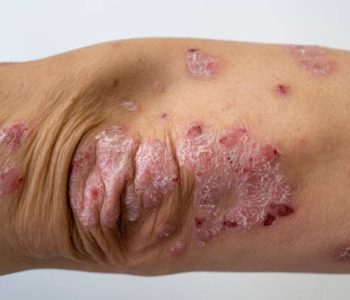Natural Treatments for Inverse Psoriasis: Effective Ways to Soothe and Manage Symptoms
Introduction
Inverse psoriasis is a chronic skin condition that causes red, shiny, and inflamed patches of skin, often occurring in areas with skin folds, such as under the breasts, around the groin, elbow and near the armpits. Unlike other types of psoriasis, it doesn’t produce thick, scaly plaques but presents as smooth, irritated skin.

What is Inverse Psoriasis?
Inverse psoriasis is a specific type of psoriasis that affects moist and sensitive areas of the body, particularly where skin rubs against skin. These inflamed patches can cause significant discomfort and irritation.
Psoriasis vs. Inverse Psoriasis: What’s the Difference?
Psoriasis typically involves thick, scaly patches on areas like the elbows, knees, and scalp. In contrast, inverse psoriasis occurs in skin folds, presenting as smooth, red patches without scaling, and is often worsened by friction and sweating.
Who is Affected by Inverse Psoriasis?
Inverse psoriasis can affect anyone, but it is more common in individuals with a family history of psoriasis or those who are overweight. It equally affects men and women and can develop at any stage of life.
Is Inverse Psoriasis Serious?
While not life-threatening, inverse psoriasis can significantly impact a person’s quality of life. The condition can cause discomfort, itching, and an increased risk of infections if left untreated.
How Does Inverse Psoriasis Impact the Body?
Inverse psoriasis affects areas of the body where skin rubs together, leading to:
- Red, tender, and shiny patches of skin
- Painful irritation exacerbated by heat, moisture, and friction
- A higher likelihood of developing secondary skin infections
- Recognizing the Symptoms of Inverse Psoriasis
- Smooth, red patches of inflamed skin
- Discomfort or pain in areas like the armpits, under the breasts, or groin
- Irritation worsened by sweating or physical activity
- Skin fissures or cracks in severe cases
- Increased risk of secondary bacterial or fungal infections
What Causes Inverse Psoriasis?
- Genetic Factors: A family history of psoriasis increases susceptibility.
- Immune Dysfunction: Overactive immune responses trigger inflammation in skin folds.
- Environmental Triggers: Heat, humidity, and friction intensify symptoms.
- Lifestyle Factors: Obesity and poor hygiene exacerbate the condition.
Suffering from Inverse Psoriasis?
We can help!
Diagnosis and Testing for Inverse Psoriasis
How Is Inverse Psoriasis Diagnosed?
Diagnosis is often made based on the appearance of the skin and a thorough medical history review by a healthcare provider.
What Tests Are Used for Diagnosis?
In some cases, a skin biopsy may be conducted to rule out other conditions such as fungal infections or dermatitis.
Effective Natural Treatments for Inverse Psoriasis
- Aloe Vera Gel: Soothes inflammation and moisturizes the skin.
- Oatmeal Baths: Alleviates itching and irritation.
- Coconut Oil: Reduces friction and hydrates skin folds.
- Turmeric: Known for its anti-inflammatory properties, it can help alleviate symptoms.
Home Remedies to Ease Symptoms
- Keep Skin Dry: Gently pat affected areas dry after bathing.
- Wear Loose, Breathable Clothing: Opt for lightweight cotton fabrics.
- Avoid Irritants: Stay away from harsh soaps and detergents.
- Cool Compresses: Apply to inflamed areas for quick relief.
How to Prevent Inverse Psoriasis Flare-ups
- Maintain a healthy weight to reduce friction in skin folds.
- Follow a consistent skincare routine to keep the skin hydrated and clean.
- Manage stress levels through techniques like yoga or meditation.
- Avoid known triggers such as extreme heat, excessive sweating, or skin irritants.
With consistent treatment and lifestyle changes, most people can manage symptoms effectively.
Possible Complications of Inverse Psoriasis
If untreated, inverse psoriasis may lead to:
- Secondary infections in affected areas
- Skin damage or fissures
- Emotional distress or reduced quality of life
Conclusion
Managing inverse psoriasis involves a holistic approach that combines natural remedies, lifestyle adjustments, and expert medical care. Early and consistent management can help you effectively control symptoms, prevent flare-ups, and improve your overall quality of life.
Are you tired of dealing with the discomfort and frustration of inverse psoriasis? Don’t let it take over your life. Visit Heal Psoriasis to explore the best treatments for inverse psoriasis tailored to your needs. Contact us today to learn more about our psoriasis treatments and take the first step toward healthier, happier skin!
FAQs
Q1. Can stress trigger inverse psoriasis?
Yes, stress is a common trigger for inverse psoriasis flare-ups. Managing stress through mindfulness or exercise can reduce the frequency of episodes.
Q2. Is inverse psoriasis contagious?
No, inverse psoriasis is not contagious. It is an autoimmune condition and cannot be transmitted to others.
Q3. Can diet help improve inverse psoriasis?
Yes, a diet rich in anti-inflammatory foods like leafy greens, berries, and omega-3 fatty acids can help reduce symptoms.
Q4. Are there effective over-the-counter remedies?
Moisturizers and hydrocortisone creams can provide temporary relief from inverse psoriasis. For persistent symptoms, consult a ayurvedic skin specialist near you.
Q5. How often should I use moisturizer on affected areas?
Apply moisturizer at least twice a day or whenever the skin feels dry or irritated.



